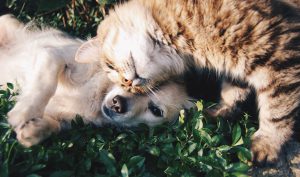Written by Laure-Anne Visele (BSc, MSc, PG Dip, O&O), canine behaviourist and dog training instructor
5 March 2021
Photo credits at the end of the post
OhMyDog stays on top of scientific developments on dog behaviour. Whenever we find an interesting study, we translate for you in layman’s terms. This study on the use of pheromone diffusers to improve dog-cat relationships in your house made it on our radar.
Study aim
This July 2020 study from Daniel Mills’ research team compared the effect of pheromone diffusers for cats and dogs, respectively, on reducing dog-cat problems in a household.
The authors compared the effect of Feliway (cat appeasing pheromone) and Adaptil (dog appeasing pheromone) in a handful of households where the cat-dog relationship was not ideal (fear, conflict, chasing, etc.).
Methodology
The researchers attributed the cat treatment to part of the sample, and the dog treatment to the other part of the sample. They then asked the owners to evaluate improvements in the cat-dog relationship over a 6-week period and complete a survey.
This study’s design had some reasons for concern, among which:
1. Very small sample size (17 households): this is typical of companion animal behaviour studies
2. Not placebo-controlled: the researchers compared the cat and dog pheromone diffusers, but they did not compare these to placebo/sham treatment (e.g. inert oil or coloured water in the diffuser).
3. Survey-based: it relied on owners’ reporting of improvements, bringing it wide open to the placebo by proxy effect. That’s how that works: “I did something so now I want it to have worked so now I am biased to see signs of improvement in the dog-cat relationship in my house, therefore I am more relaxed about it, therefore there are improvements”.

Results
They noticed a large and significant improvement using either products, interestingly, especially on two fronts: less fearful cat & less relentless dog. Interestingly, the cats would show improvement on the dog pheromone, and vice and versa. This is either the reflection of:
- A potential design flaw in the study, and/or
- The interconnected nature of dog-cat problems (e.g. dog stops relentlessly pursuing the cat -> cat is less fearful and jumpy -> dog is less and less interested in chasing the cat), and/or
- (Partially) common biological pathways in pheromone processing in both species.
Take-home
Given the limited costs of these pheromones and the fact that they do no harm, why not give both a try? Let’s do some citizen science and let us know how you get on!
Reference
Prior, M.R. & Mills, D.S. (2020) – Cats vs. Dogs: The Efficacy of Feliway FriendsTM and AdaptilTM Products in Multispecies Homes – Front. Vet. Sci., 10 July 2020
Photo credits
Photo of a cat and a dog: Courtesy of Snapwire, on Pexel. License: Pexel license. No modifications made.
